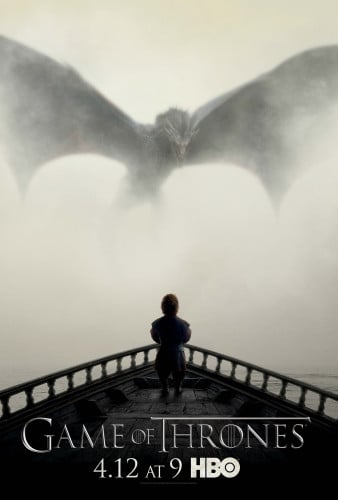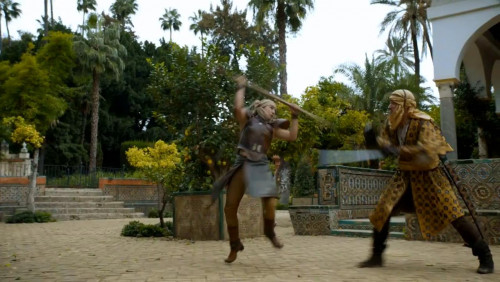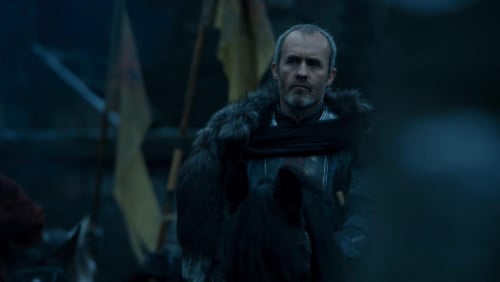Westeros
The 'A Song of Ice and Fire' Domain
Features
Last month, we posted our impressions from the world premiere, with a follow-up video regarding a particular aspect of that episode. Since then, we’ve received screeners of the first four episodes of the season, and as with previous seasons, we thought we’d offer early impressions based on those first four episodes. Regarding our remarks on the first episode, they remain largely unchanged: it’s a typical first episode, heavily packed with a lot of short scenes, and it doesn’t get much narrative momentum as it has the difficult job of catching up viewers to the current status quo.
Surprisingly, in many ways the second episode feels very similar, suggesting that the the growth of the story means that it now takes the better part of two episodes before significant advancement can take place. This may be a problem for the remaining seasons of the show, unless they become quite ruthless with some of their storylines.

Three particular areas of season 5 seem worth talking about in this discussion, and the first of these is the one that dominated our video: changes. This is a season with a host of changes, many minor, but a handful being among the most substantial deviations from the novels that the series has ever tried. In some cases, changes are presented as a means to simply close down one particular avenue of the story: we discuss one of those at some length in the video involving the death of a certain character in the first episode, and another change of this kind presents itself in the third episode as readers of the novels come to realize that a significant section of story for one popular character (a section that has implications for other, equally significant storylines, to boot) has been excised in its entirety to speed on a character’s journey.
This puts me in mind of one of the analogies George R.R. Martin has lately brought forward when asked about the different stories of the novels and the TV show. After asking how many children Scarlett O’Hara has in Gone with the Wind, GRRM notes that while she has 3 in the original novel, she only has 3 in the movie. This, George notes, is a significant storytelling difference in the case of Gone with the Wind, and yet the film (noted for a number other such differences) is considered a faithful adaptation of the novel, and one that is the highest grossing film in history once adjusted for inflation.
Martin’s example is especially appropriate, because he’s referring to a very deliberate approach taken by producer David O. Selznick who saw before him the very difficult task of adapting an extremely popular novel and had over his career come to conclusions of what did and did not work. Here’s a quote from a memo of Selznick’s to one of the first screenwriters for Gone in the Wind found in Memo from David O. Selznick, a collection of Selznick’s correspondence, memos, and more related to his many films:
“We have an even greater problem in Gone With the Wind, because it is so fresh in people’s minds. In the case of ninety-nine people out of a hundred who read and saw Copperfield, there were many years between the reading and the seeing. In the case of Gone With the Wind there will be only a matter of months, and people seem to be simply passionate about the details of the book.
All of this is a prologue to saying that I urge you very strongly indeed against making minor changes, a few of which you have indicated in your adaptation, and which I will note fully. These minor changes may give us slight improvements, but there will be five or ten million readers on our heads for them; where, for the most part, they will recognize the obvious necessity of our making drastic cuts.
I feel, too, that we should not attempt to correct seeming faults of construction. I have learned to avoid trying to improve on success. One never knows what chemicals have gone to make up something that has appealed to millions of people, and how many seeming faults of construction have been part of the whole, and how much the balÂ%ADance would be offset by making changes that we in our innocence, or even in our ability, consider wrong. “
His evident success with these maxims—avoid minor changes, be willing to make drastic cuts, and avoid attempting to improve the story—seem to have application to Game of Thrones. The changes we’ve witnessed have been, in some cases, simply an approach to making drastic cuts; Selznick would approve. Other changes seen this season are trickier, however: on the one hand seeming to be ways to cut certain story threads that are contained in the novels, but then presenting such a radically different story that one wonders if some of them may not, in fact, be an attempt by the writers to improve on the adapted material. Selznick was very dubious of the idea; so, too, is Martin, as noted in the Nerdist podcast:
Looking at some of the changes we witness in the first four episodes, some frankly do feel extraneous, changes made for the sake of what the writers believe works better rather than because it’s a necessity. That remains hard to swallow for us, especially when the changes strike us as actively unsuccessful (the Sand Snakes, for example, have been compared to “B-movie bad girls” in a review of the screeners by none other than EW, a magazine that has had unprecedented levels of access to the production; they’re not wrong, sadly) and for at least some other fans of the novels who watch the show. But others clearly are cuts—shortcuts, one might say—to try and fit storylines into the time (speculatively) alloted, and should be understood in that light. Whether the cuts are elegantly executed, whether they’re able to successfully carve out these shortcuts and make the journey interesting, remains something for viewers to decide.
One obvious consequence of cutting—and, truth be told, of extraneous changes—is that at times nuances and subtleties that enrich the novels are lost. The novels are very substantial, and often relatively prosaic, but sometimes a kind of poetry comes through when Martin embraces fantasy’s ability to help us “find the colors again”. The show is even more prosaic, and much less poetic. More, it can be thunderingly obvious at times, telegraphing things. Episode 3, “High Sparrow”, features a particularly remarkable example of this kind, a statement from a character that seems to scream, “PAY ATTENTION TO THIS, IT’S FORESHADOWING.” It’s very Chekovian.
One of the areas that has seen the most change in this fashion—change that removes nuance—is King’s Landing. To our surprise, in fact: what was present in the novels regarding the presence of a notable new power struck us as very adaptable, presenting a good view of social and religious dynamics in the aftermath of the War of the Five Kings and at the same time providing far greater insight into the character of Cersei Lannister. What we have instead seems like an extreme of soft-pedaling what’s going on, to start with, and a sudden and violent turn to a very different kind of extreme, the extremes of religious bigotry going above and beyond how things stand in A Song of Ice and Fire. Wedded as it is to some very distinct changes to the fortunes of a secondary character, and the continued smoothing out of the rough edges of one Cersei Lannister, leaving out the extremes of her personality and her actions as witnessed in A Dance with Dragons. It’s surprisingly unsatisfying viewing, and not helped by the seeming surge in the show’s gratuitous nudity quota, with several scenes featuring bevies of nude people (matched by similar scenes in a couple of other areas of the narrative).
On the other hand, the Wall has proved a notably entertaining area, despite the drastic storyline cutting in episode 1 and severe (and slightly awkward) compression in episode 2. Kit Harrington gets some of his best material to date, and has a terrific foil in Stephen Dillane’s Stannis Baratheon… who, as it happens, steals the show (along with Kerry Ingram’s Shireen) in the single best scene in the first four episodes. Coming into the fourth episode, “Sons of the Harpy”, written by newcomer Dave Hill, who has previously worked in the production as assistant to David and Dan and, like Bryan Cogman before him, has helped keep track of the setting lore. Hill writes a number of quite good scenes in the fourth episode, but the Stannis scene is particularly rich in a willingness to imply things without being explicit, and in so doing managing to convey Stannis’s iron will in a way that we’ve never seen before. And, yes, this is an invented scene, for those who pretend to be amazed that we can enjoy new material; this feels like an insight into a moment between Shireen and Stannis that could well and truly come from the novels, much as many invented scenes in the first season felt like they caught moments between chapters or out of the eyes of point of view characters.
“Sons of the Harpy” also features one other thing we’d like to discuss, because it ties into some of what has come before: history, events of the past, come up in a big way after several seasons of studiously ignoring them. Why the writers chose to wait until now—not just “now in season 5” but “now in season 5, episode 4”—to delve into one of the central aspects of the recent, momentous past is a bit baffling to us admittedly. An outsider, completely unaware, would fit together the not one, not two, but three separate scenes that are inter-connected in terms of the history means, again Something Important. And not just anything important, but presumably something the writers of the show just came up with given the urgency in which pieces are dropped all into one episode. That, or they don’t trust viewers to take note if it were spread out over episodes?
I can’t say, but it’s been a common complaint of fans of the lore and history of the setting that they have largely left some very important parts of it out of the picture and so they won’t be surprised to see that they have put themselves in a corner. Better late than never, perhaps, as the old maxim says… but it does lead to its being expressed unsubtly, and also to some somewhat shaky approaches to divulging it. In particular, the key sequence in the three historical discussions comes at an important place, one seen before and providing some important visual touchstones… but the person revealing the history is not particularly connected to it, not someone for whom there’s any sense that the events of the past weigh on him. No surprise, though, that this character ended up the bearer of unrelated exposition, however, as (infamously) this is not the first time he’s been the designated bearer of tidings from the recent past.
Overall, the story remains reasonably engaging, although not all areas are equal in that engagement (but then, they never are), and one in particular (the Winterfell storyline) threatens to run off the rails if the writers aren’t very careful with how they proceed going forward. If I had a guess, the first four episodes will follow something of a similar trajectory in fan esteem as the first four episodes of season 3 did, and possibly displacing it as the overall best first four episodes (seen as a whole) of any season; though that Winterfell storyline, come to think of it, may cause enough uproar to prove me wrong. Just as with season 3, the first two season 5 episodes are a bit ponderous, while the third and fourth kick up the pace in some ways and present some of the strongest (and, in some cases, the most shocking) scenes in the opening episodes.
We’ll have to wait and see if the rest of the viewing audience feels the same.

